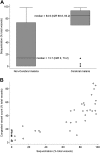Sequestration and microvascular congestion are associated with coma in human cerebral malaria
- PMID: 22207648
- PMCID: PMC3266137
- DOI: 10.1093/infdis/jir812
Sequestration and microvascular congestion are associated with coma in human cerebral malaria
Erratum in
- J Infect Dis. 2012 Nov;206(9):1483
Abstract
The pathogenesis of coma in severe Plasmodium falciparum malaria remains poorly understood. Obstruction of the brain microvasculature because of sequestration of parasitized red blood cells (pRBCs) represents one mechanism that could contribute to coma in cerebral malaria. Quantitative postmortem microscopy of brain sections from Vietnamese adults dying of malaria confirmed that sequestration in the cerebral microvasculature was significantly higher in patients with cerebral malaria (CM; n = 21) than in patients with non-CM (n = 23). Sequestration of pRBCs and CM was also significantly associated with increased microvascular congestion by infected and uninfected erythrocytes. Clinicopathological correlation showed that sequestration and congestion were significantly associated with deeper levels of premortem coma and shorter time to death. Microvascular congestion and sequestration were highly correlated as microscopic findings but were independent predictors of a clinical diagnosis of CM. Increased microvascular congestion accompanies coma in CM, associated with parasite sequestration in the cerebral microvasculature.
Figures


Similar articles
-
An ultrastructural study of the brain in fatal Plasmodium falciparum malaria.Am J Trop Med Hyg. 2003 Oct;69(4):345-59. Am J Trop Med Hyg. 2003. PMID: 14640492
-
Severity of retinopathy parallels the degree of parasite sequestration in the eyes and brains of malawian children with fatal cerebral malaria.J Infect Dis. 2015 Jun 15;211(12):1977-86. doi: 10.1093/infdis/jiu592. Epub 2014 Oct 28. J Infect Dis. 2015. PMID: 25351204 Free PMC article.
-
Coma in fatal adult human malaria is not caused by cerebral oedema.Malar J. 2011 Sep 17;10:267. doi: 10.1186/1475-2875-10-267. Malar J. 2011. PMID: 21923924 Free PMC article.
-
Cerebral malaria pathogenesis: revisiting parasite and host contributions.Future Microbiol. 2012 Feb;7(2):291-302. doi: 10.2217/fmb.11.155. Future Microbiol. 2012. PMID: 22324996 Review.
-
A study on the pathogenesis of human cerebral malaria and cerebral babesiosis.Mem Inst Oswaldo Cruz. 1992;87 Suppl 3:297-301. doi: 10.1590/s0074-02761992000700051. Mem Inst Oswaldo Cruz. 1992. PMID: 1343706 Review.
Cited by
-
The fluid management of adults with severe malaria.Crit Care. 2014 Nov 21;18(6):642. doi: 10.1186/s13054-014-0642-6. Crit Care. 2014. PMID: 25629462 Free PMC article.
-
Unravelling mysteries at the perivascular space: a new rationale for cerebral malaria pathogenesis.Trends Parasitol. 2024 Jan;40(1):28-44. doi: 10.1016/j.pt.2023.11.005. Epub 2023 Dec 8. Trends Parasitol. 2024. PMID: 38065791 Free PMC article. Review.
-
Quantitative Assessment of Multiorgan Sequestration of Parasites in Fatal Pediatric Cerebral Malaria.J Infect Dis. 2015 Oct 15;212(8):1317-21. doi: 10.1093/infdis/jiv205. Epub 2015 Apr 7. J Infect Dis. 2015. PMID: 25852120 Free PMC article.
-
Lethal malaria: Marchiafava and Bignami were right.J Infect Dis. 2013 Jul 15;208(2):192-8. doi: 10.1093/infdis/jit116. Epub 2013 Apr 12. J Infect Dis. 2013. PMID: 23585685 Free PMC article. Review.
-
Investigating the Pathogenesis of Severe Malaria: A Multidisciplinary and Cross-Geographical Approach.Am J Trop Med Hyg. 2015 Sep;93(3 Suppl):42-56. doi: 10.4269/ajtmh.14-0841. Epub 2015 Aug 10. Am J Trop Med Hyg. 2015. PMID: 26259939 Free PMC article. Review.
References
-
- Severe falciparum malaria. World Health Organization, Communicable Diseases Cluster. Trans R Soc Trop Med Hyg. 2000;94(Suppl 1):S1–90. - PubMed
-
- Newton CR, Taylor TE, Whitten RO. Pathophysiology of fatal falciparum malaria in African children. Am J Trop Med Hyg. 1998;58:673–83. - PubMed
-
- Lengeler C. Insecticide-treated bed nets and curtains for preventing malaria. Cochrane Database Syst Rev. 2004;(2) CD000363. - PubMed
Publication types
MeSH terms
Grants and funding
LinkOut - more resources
Full Text Sources
Medical

